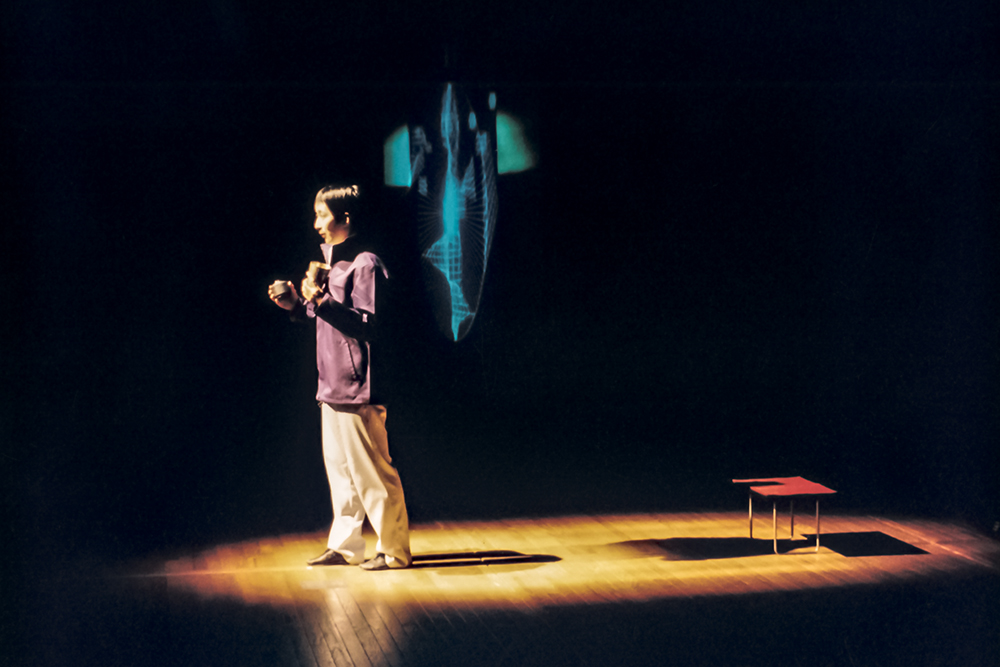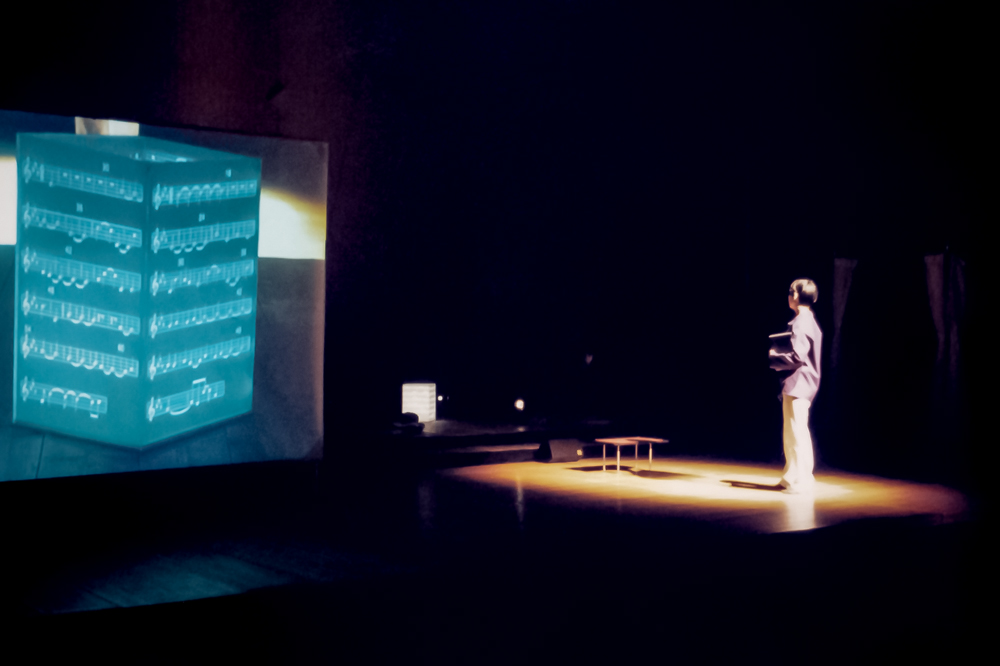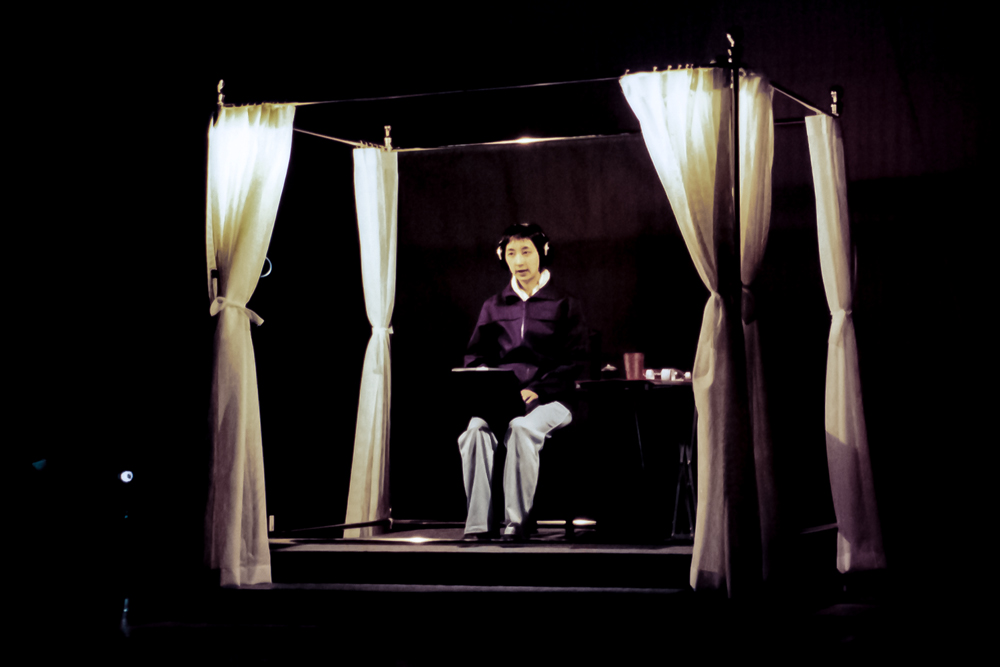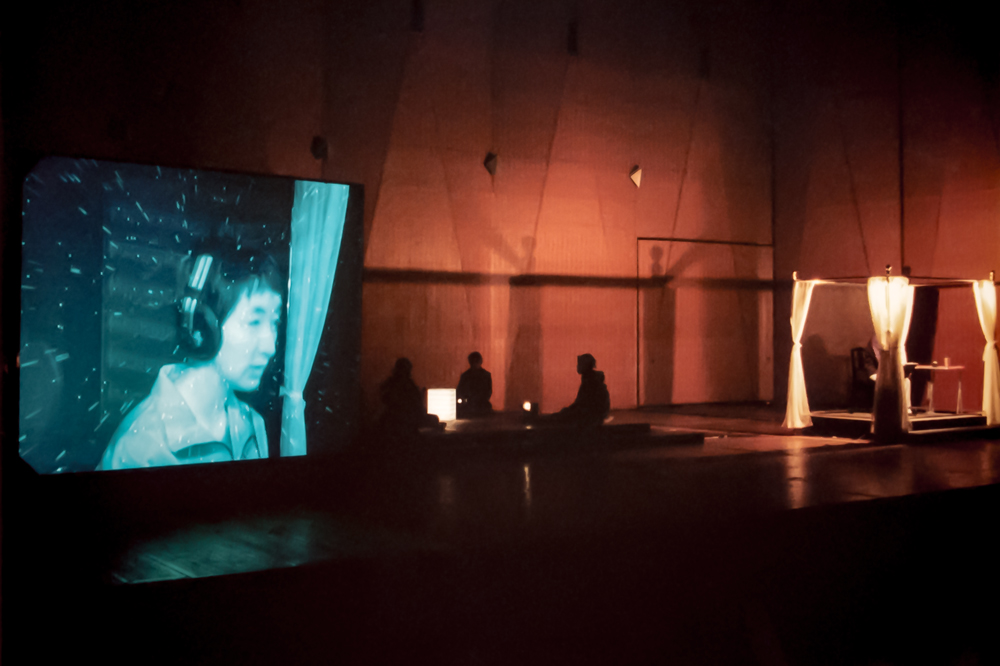
Masahiro Miwa + Shinjiro Maeda
Monologue Opera
THE NEW ERA
The word is a promise / The promised time is here
I am drawn up by the light / I will become a song
17th Keizo Saji Prize [SUNTORY FOUNDATION for the ARTS] The word is a promise / The promised time is here I am drawn up by the light / I will become a song
17th Keizo Saji Prize [SUNTORY FOUNDATION for the ARTS]Missionary broadcast〈The Divine Melody〉24 hours a day, with a message for believers at the stroke of midnight every hour
http://neuezeit.org/
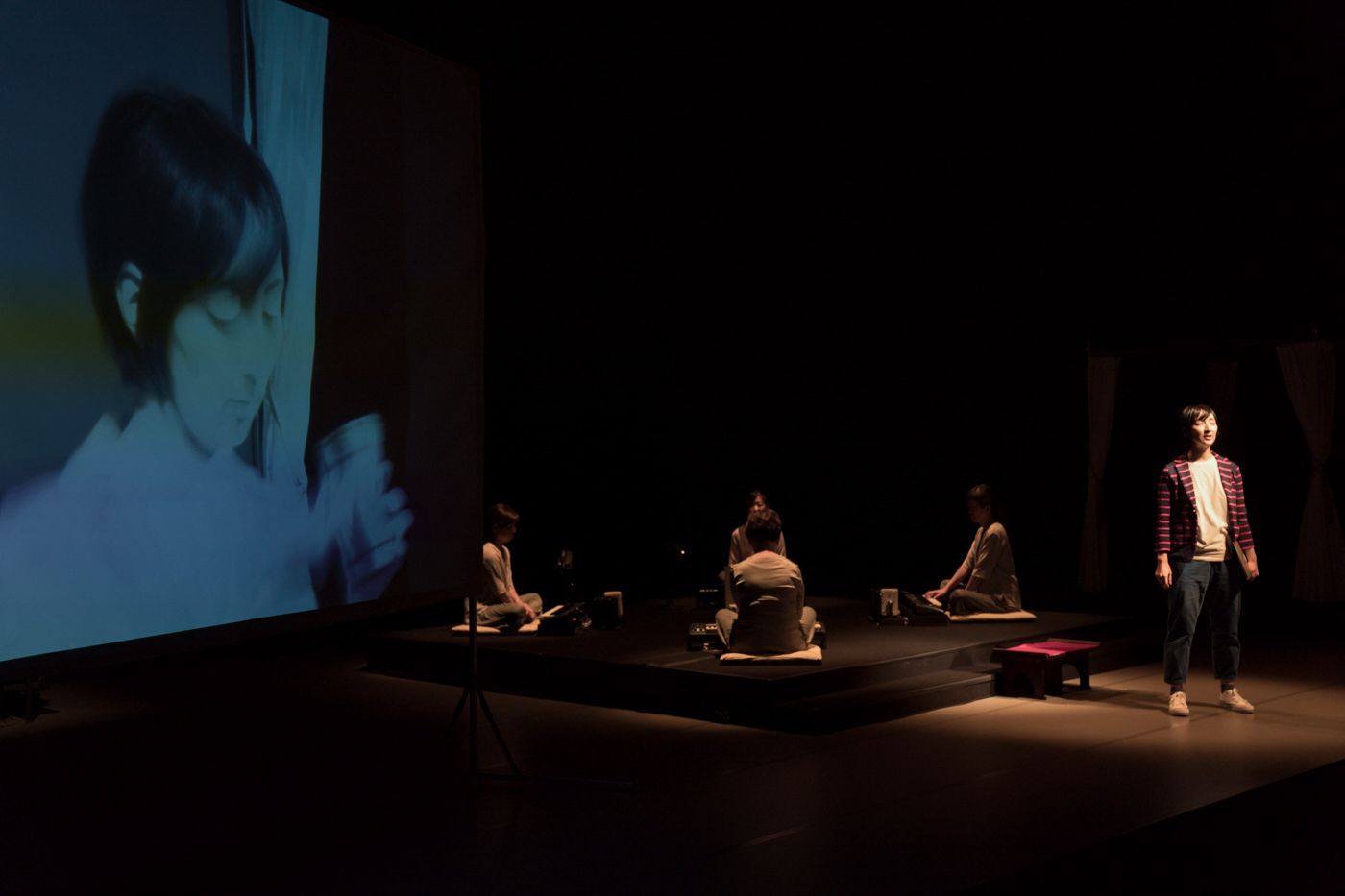 Photo by Naoshi Hatori
Photo by Naoshi HatoriOutline
The digital network that is connecting the world on a global scale is spreading like wildfire. It is becoming a book of knowledge that can gather and process huge amounts of information, a brain for the whole world that has abilities that far exceed that of individual humans. Before long this brain will begin to address the areas in the book that have been left blank by humans, it will start to automatically generate the secretsof the creation of the universe and the origin of life, and will release these secrets as a secret code onto the internet.
There are people who intuitively understand the meaning of this strange code that floats around on the internet. They have learnt that the code is directly conveyed to humans not by letters and words, but by transforming the code into music and sound. They have also discovered that it is something that was already understood by humans belonging to ancient civilizations. People have exchanged this knowledge, and with further intuitiveness a faith in the internet, a religion has been born.
The gospel of this religion preaches that one should suicide, that is, do away with the flesh and attain a purely spiritual existence. It states that the objective of human existence is to offer oneself as a sacrifice to God, the principles of the universe, and become part of the glorious melody. This melody, or sound has the magical ability to stimulate to the maximum parts of the human brain that are not usually utilized. It also has the awesome power to awaken what has been handed down as a genealogical record from ancient civilizations that have long since ceased to exist.
The melody is the only expression comprehendible to humans of God's language, something that we normally cannot understand. To do away with the physical body and become part of God's melody is the final goal for humans, a goal that is not attainable by other biological beings. Originally, human language was also structurally regulated in the same way as "God's language".
Content and Composition
This mass, an initiation ceremony for death is the most significant life event for the believers. The mass is a real space where believers share the music and sound that is created from the strange code that comes from the internet, a solemn place where it is possible to listen directly to God's language through the music. The ceremony centers upon the leading actor who will offer himself up as a sacrifice in front of the other followers and is held according to the following order.
1. Alleluia
-All present listen to Godユs melody performed by virgin maidens.
2. Archive
-The appearance and genealogical information of the actor are captured and sent as data onto the net (and left there).
3. Reincarnation
-The leading actor drinks some poison and while waiting to die sings God's language, thanks to God and his confession.
In order to confirm that the believer who died during the ceremony has become part of the melody, data of the believer will be recalled with a matching part of the melody and remembered amongst feelings of respect and envy.
The leading actor for the opera, the mass, is a fourteen years old boy.
The Stage
The following features of the opera are made possible with the use of specially developed systems and several computers including:
A sound generation system based on the performance of four female keyboard players (principally a performance in keeping with sine waves);
A video imaging system to synchronize the musical score of the four female keyboard player's performance and the progress of the music;
An imaging system to project prepared images and images from several (infrared)cameras on stage onto a large screen;
A delay system to delay the video images on the stage;
Control systems to control other sound sources and lighting etc.
The electronics and the network fully utilize the latest technology. They make the stage both complicated and intricate and are themselves a form of the opera's expression.
AICHI
- DATE
- Dec.8, 9, 2017
- VENUE
- Aichi Prefectural Art Theater The Mini Theater >Google Map
http://www.aac.pref.aichi.jp/
OSAKA
- DATE
- Dec.16, 2017
- VENUE
- Aioi Nissay Dowa Insurance THE PHOENIX HALL >Google Map
http://phoenixhall.jp/
Cast
14 years old boy: Reisiu Sakai
Four priestesses (keyboards): Chiaki Iwano, Mizuho Kinoshita, Yumi Higasa, Yoshiko Morioka
1st Follower (video operator): Ken Furudate
2nd Follower (sound operator): Tomoko Ueyama
3rd Follower (mixing operator): Yoshitaka Oishi
Creators
Composer/ librettist/ musical director: Masahiro Miwa
Director/ video designer: Shinjiro Maeda
Media authoring: Ken Furudate
Graphic designer: Akio Okamoto
Formant vocal synthesis: Nobuyasu Sakonda
Sound designer: Tomoko Ueyama
Lighting designer: Koji Azegami (Aichi Prefectural Art Theater)
Costume/make-up designer: Akiko Iwai
Stage Manager: Hiroaki Yamaguchi (Aichi Prefectural Art Theater)
Technical cordinator (stage) : Yoshinori Sekoguchi (Aichi Prefectural Art Theater)
Technical director assistant: Yoshitaka Oishi
Technical adviser: Yuichi Matsumoto, Kyo Akabane
Visual designer for publicity: Rina Okazawa
Production manager/ director assistant: Ayako Fukunaga (naya collective Ltd.)
Proposal: Nobuhiro Ito
Producers: Akiko Fujii (Aichi Prefectural Art Theater) , Yasufumi Miyaji (Aioi Nissay Dowa Insurance THE PHOENIX HALL)
Collaborated with The Institute of Advanced Media Arts and Sciences [IAMAS] , Osaka University "Kioku no Gekijo" Project
Sponsor|
 (Osaka)
(Osaka)Supported by the Agency for Cultural Affairs (for performances in Aichi), Asahi Group Arts Foundation (for the performance in Osaka)
Commissioned by 22nd Century Club in 2000



Miwa Masahiro 三輪眞弘
A musical composer, Miwa has presented a great number of works with algorithmic composition, a method of composition that utilizes computers. He has won 1st place in the 10th The IRINO PRIZE, 1st place in the 14th Concorso Internationale Luigi Russoro, won the 14th Akutagawa Award for Music Composition, and the 2010 Minister of Education Award for Fine Arts (Development of the Arts Division) in addition to many other awards. In 2007, his “Reverse Simulation Music” won the Golden Nica Award in the Digital Music Division of the Ars Electronica. He is a professor at the Institute of Advanced Media Arts and Sciences [IAMAS]. Elder brother of the the Formant Brothers.
http://www.iamas.ac.jp/~mmiwa/
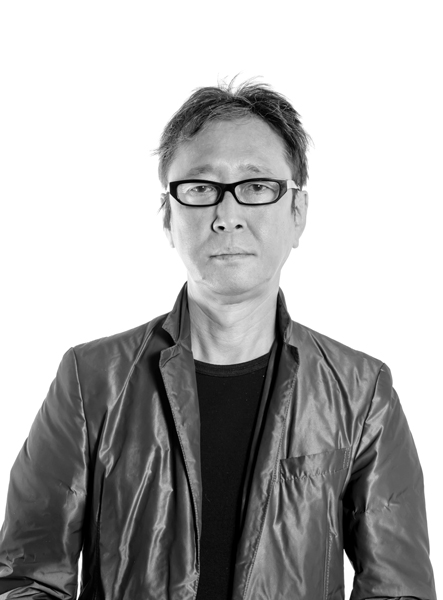
Maeda Shinjiro 前田真二郎
Maeda presents his work, which spans the categories of video, media art and documentary, at film festivals and exhibitions like the Image Forum Festival, the Ebisu International Festival for Art and Alternative Visions, and the Yamagata International Documentary Film Festival. He actively plans exhibitions, collaborating with artists from theatre, art and other fields. He has been supervising director of the DVD label SOL CHORD since 2005. He is a professor at the Institute of Advanced Media Arts and Sciences [IAMAS].
http://maedashinjiro.jp/
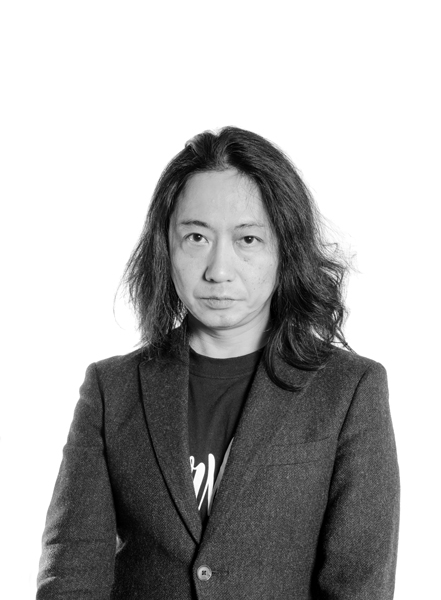
Sakai Reisiu さかい れいしう
She studied singing under Prof. Mamiko Saeki at Musashino Academia Musicae, and algorithmic composition under Prof. Masahiro Miwa at the Institute of Advanced Media Arts and Sciences (IAMAS). She played the leading role in the Monologue Opera “The New Era” (performed in Tokyo and Kyoto, 2000) .She completed “Noto Satoyama Satoumi Meister Training Program” of Kanazawa University in 2014, and she has been planning concerts and art events where both children and adults can enjoy in “Satoyama”.
http://reisiu.sakura.ne.jp/wordpress/
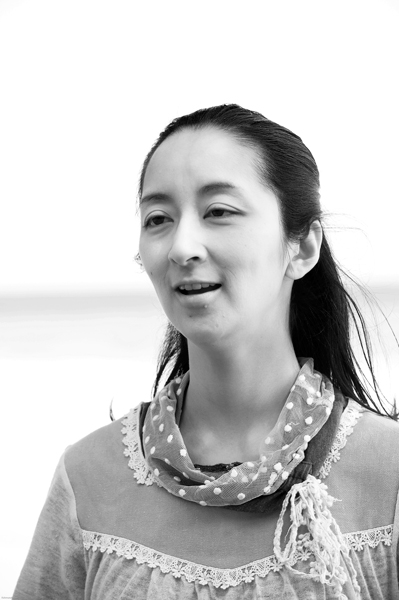
写真| 幸村真佐男 photo by Masao Kohmra
Re-staging “The New Era”
Masahiro Miwa
2017/ 5/29
I have been thinking about the re-staging of this opera after 17 years. Specifically, I wondered whether what I had written was indeed an opera after all. I remember that Tatsuo Yoshitake of the 22nd Century Club, who had commissioned this work, asked me to compose an opera “with one singer and an orchestra section that is not too big .” I explored what could be done under these (limited) conditions, and eventually decided that one thing was clear—I did not want to simply follow along in the style and production process of the so-called “new opera,” of which there had been countless examples in 20th century contemporary music. As far as I am concerned, many of those productions were rather uninteresting as they ended up being abstract and esoteric. Therefore, I decided to ignore the conventions of “opera (works)” and instead, employed an extremely unique format consisting of one singer and four keyboardists, where all the sounds other than voice (including voice samples), in addition to the imagery, are created electronically and controlled by three operators on stage. Since the premiere performance of the work was in two different concert halls in Kyoto and Tokyo, we did not use any of the venue’s audio or lighting equipment. Instead, we created our own computer-controlled system, and all performers and operators other than the keyboardists—including the singer (!)—were then students at the Institute of Advanced Media Arts and Sciences (IAMAS). When I reflect on that now, I realize just how audacious that was. I also remember spending days and nights at the school making preparations and rehearsing with the filmmaker Shinjiro Maeda, my colleague at IAMAS, as we counted down the days until the premiere.
The fact that the “implementation” of such an opera had at its core computer-controlled images and sounds became an integral part of the content of the opera itself; thus, it is quite naturally linked to the initiation of the death of a religious group (“The New Era”)—that is, the recreation of this ceremony—through the course of the opera. Specifically, the entire opera is a “hypothetical stage” set up for the purpose of this ceremony, and the images and sounds do not, therefore, aim to be a great spectacle that makes use of cutting-edge technology of the time. Rather, it was performed in a manner that was meant to be simultaneously serious and tacky . Needless to say, this was because I was using the Aum Shinrikyo incident—which was still fresh on everyone’s mind—as a reference. This is due to the fact that I wanted this work’s main theme to be the odd affinity between religious faith and modern science and technology that was apparent in, for example, their “brainwashing videos” and “head-gear.”
Now, 17 years later when the computers and peripheral devices we used then are no longer used, I feel that the significance of “reviving” the work with the use of old electronic devices is above and beyond the mere “re-staging” of the work. This is because in our world now—a world that could not continue to exist without an enormous energy supply and advanced technology (i.e., “machinery”)—this work stands as the first “opera” to delve into the relationship between “the world/the arts/music for the purpose of humanity” and “machinery,” and because it was first created in Japan 17 years ago. We have repeatedly debated issues about whether to perform the sounds and images using the technology of 17 years ago and whether to “update” the very long text that was first written 17 years ago. In the end, we decided to avoid this completely. We made this decision because the theme of this opera has hardly aged over the last 17 years; indeed, the relationship between humans and machines has become even clearer than it previously was, and thus, the issue had become even more realistic than before. The border of a realm of (religious) faith separated from everyday society and known as “satyam” has dissolved, and as a result, a variety of fanatical “beliefs” have spread throughout the world via the media and the Internet. This has, in turn, led to people violently attacking and counterattacking each other. However, it is not my intention to insist that this opera—which depicts the situation that existed 17 years ago—was prophetic. Nevertheless, nanotechnology, neurotechnology, biotechnology, artificial intelligence, and all other forms of advanced technology have progressed at break-neck speeds. Looking back from this vantage point, I get the sense that at its essence, this work properly hinted at “humans as the object of machine calculations” and how that (mental) world would develop. In particular, I am referring to humans whose personalities are created by machines and who therefore cannot exist without being subordinate to machines . This indeed is what is meant by “the odd affinity between faith and modern science & technology,” and it is the future world of humans that I attempted to depict in the form of an “opera” 17 years ago. However, I still have no idea whether this type of work would be called an “opera.”
Voice-like sounds and Sound-like voices
2016/11/3Twenty years ago, I became an instructor at the Gifu Prefectural International Academy of Information Arts and Sciences (later known as the Institute of Advanced Media Arts and Sciences: IAMAS), founded in 1996. This event marked an end to my long years of study and composition in Germany. While I spent my time at the newly opened IAMAS in Ogaki City, a school that advocated a “fusion between science and the arts,” I also experienced a great deal of suffering. Specifically, I had lost my ability to know how I should proceed as a composer at that school, or rather in Japan. The environment in Japan was too different for me to simply continue with the work I had been doing in Germany. In addition, it was difficult for me to get a sense of the state of contemporary music and the audiences in Japan. Then, in 1998, in the midst of this “confusion,” during which I could find nothing to work on, I thought of a form of performance (a system) in which four keyboardists would play in a quartet while reading a musical score and generate human voices. This led to the creation of “Silhouette of Words, or Alleluia” (kotoba no kage, mata wa areruya). Another source of my “confusion” at that time was the discomfort I felt due to the elusive nature of words and language in Japanese society. That discomfort took on form as a result of the “Shonen A” murders (the Kobe child murder case). It took the form of complete and total “talkativeness and silence” as well as contemplation. Moreover, it took the form of a modern media and a media technology that stirred both these fields. When I think about it now—and the same is true for the opera I will discuss below—I think that as a composer, I was somehow trying to reconcile those feelings. In other words, there was a need for me to reconcile them, and the music I was making then had no other meaning but that one
. Put another way, the “sound-like voices and voice-like sounds” that were created in the work by the hybrid system that combined humans and digital technology itself was the final answer to the issue of my confusion at that time of my life.
The next commission I received was for a “monologue opera,” or what one might call a “one-man opera.” This time I took on the challenge of “human” voices. Naturally, I wrote songs that humans were to sing, but as is evident in the program notes below, the sine waves of the four vocal parts known as “the melody of God,” which were also the “accompaniments” to those songs, were not “sounds” in the “songs” per se, but rather, they were intended to serve as the countless voices that were imprinted by people who believed in “the new era” and who were offering their own physical bodies to God. The opera tells the following story:
The modern digital network that links the entire world has become a collection of knowledge that serves as a place where an enormous amount of intellectual data are gathered and processed, and thus, it has become a “brain” for the entire world that exceeds the abilities of any individual. At some point, through its advanced symbol processing abilities, this brain produced the basic theory that explains the secrets of the origin of life and the birth of the universe, which are blank spaces in the collection of knowledge that humanity had yet to write in. These then began to wander the network in the form of wondrous cipher codes.
Some people who were able to intuit the meaning of these mysterious codes understood that they were not letters or language, but instead, had been converted into a “musical score.” They discovered that through this process of conversion into sound waves, the codes were communicating a direct message to human enlightenment, and as a result, a faith that could be called “religious” naturally arose on the network. The teachings of this “religion” held that by offering one’s physical body to God—that is, the principle of the universe—and thereby “imprinting” each individual’s genetic data onto the beautiful melody that would wander the network, they could participate in an encoding process of the universe that transcended time as well as space (April 22, 2000).
Archive | 2020
monologue opera
"The New Era"
April 20.2000
'ALTI'‐ Hall, Kyoto
April 27.2000
Kioi‐ Hall , Tokyo
Composer,scriptwriter,computer programmer:
Masahiro Miwa
Director,visual effects:
Shinjiro Maeda
Soprano:
Reisiu Sakai
Keyboards:
Kaori Iimura,Aya Usutomi,Takae Kikuchi,Tomomi Mitsui
Sound technicians:
Tomoko Ueyama,Masatsune Yoshio
Visual technicians:
Akio Okamoto,Takaaki Shimbori
Special thanks to:
Masayuki Akamatsu
Supported by:IAMAS
Sponsored,produced and commissioned by:
The 22nd Century Club
(C)Masahiro Miwa & Shinjiro Maeda
Writing opera today
2000/ 1I have long thought that I would like to write songs. However, I have never been successful at it. In the past, songs were produced in a variety of forms, and even now, I know many songs that people love and hum to themselves. I was always thinking about why I was unable to write songs that were comparable to those. I tell myself that this was the reason why I studied music. The answer to this question that occurs to me is the fact that the world that needs to be sung of and depicted in song is itself collapsing. Certainly, I personally do not believe in that sort of world, and I have made it a habit to doubt and carefully observe those who seriously make such statements. The sort of world that needs to be sung of and depicted in song is probably a world that we yearn for in some sense. We have, from the outset, destroyed this world with scientific knowledge, using the principles of world economy and competition with nuclear bombs and all other types of violence. Moreover, in the present world, it is no longer possible for us to yearn for anything.
The abilities to see the unseen world before our very eyes, conceive of hope, and yearn are the most powerful abilities that children are born with. For children, these are the things that they need to train in to become human. Indeed, I—no longer a child—have become a person who truly yearns for something, writes songs, and creates operas in the absence of the “childish” sensibility I once had. Being chased around endlessly by a utilitarian and analytical viewpoint regardless of how much ingenuity is put into them, songs inevitably go through a phase in which they sound contrived.
On the other hand, when I see people around the world celebrating the millennium, adults looking back on the past and looking toward dreams of the future, and confirming and renewing the contract between the world and humanity, I feel that our sharing in this festive time has some deep relation with music. The moment I put aside my analytical mind is the moment that I realize that these adults have in common a “childish” creativity. This is the moment in which I too dream and attempt to write songs in this current age in which it should not be possible to write songs.
However, those songs do not inspire courage in people, they do not manifest a world that is yet to be seen, and they are not infused with some enthusiastic message aimed at someone. They are simply meaninglessly repeated, like nursery songs sung by children who are merely engaged in word play. It is precisely because they are meaningless, that—like a mysterious incantation—they calm their souls.












